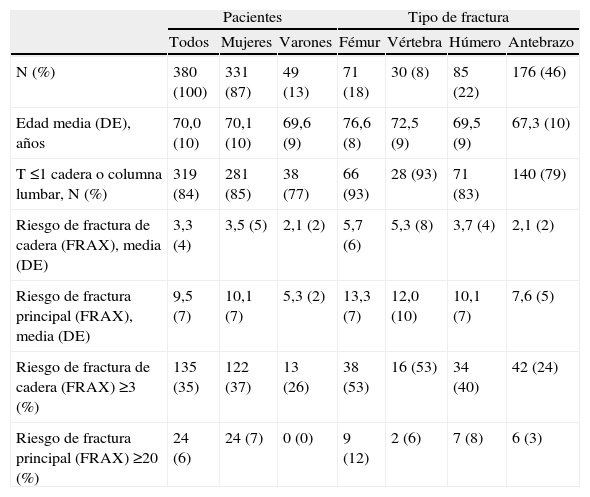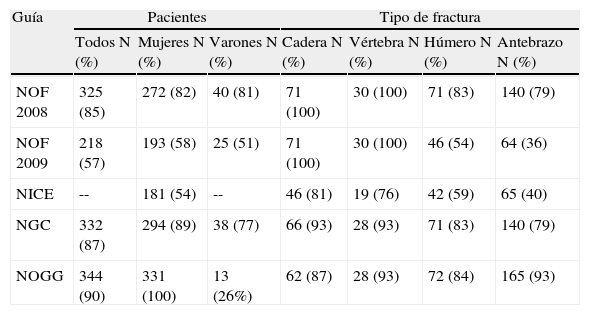Existen distintas guías para la prevención secundaria de fracturas relacionadas con la osteoporosis. El objetivo de este estudio fue analizar su aplicación en una cohorte de pacientes con fractura por fragilidad.
Pacientes y métodoLos adultos mayores de 50 años registrados en el servicio de urgencias del hospital con fractura por fragilidad fueron invitados a un estudio de prevención secundaria de fractura. Se recogieron los datos clínicos incluidos en el índice FRAX y se realizó densitometría ósea. Para el cálculo de los pacientes candidatos a prevención se emplearon las guías de manejo de la osteoporosis.
ResultadosAplicando las guías de prevención a 380 pacientes incluidos, el porcentaje de candidatos a tratamiento fue del 54-100% en las mujeres y del 26-81% en los varones. En las fracturas de cadera la cifra fue del 81 al 100% y en las de antebrazo del 36 al 93%. El riesgo de fractura de cadera por el índice FRAX fue ≥3% en el 35% de la muestra. Las guías más restrictivas fueron la National Institute for Health and Clinical Excellence y la National Osteoporosis Foundation 2009 (54-57%), a diferencia de la National Guideline Clearinghouse y la National Osteoporosis Guideline Group (87-93%).
ConclusionesExisten diferencias en el porcentaje de pacientes a tratar para prevenir nuevas fracturas según la guía de tratamiento aplicada. La inclusión del FRAX conlleva una reducción de casos a tratar.
There are different guidelines for secondary prevention of fractures related with osteoporosis. Our aim is to analyse the appliance of such guidelines in a sample of patients with fragility fracture
Patients and methodsAdult patients older than 50 years attended in the emergency department with a fragility fracture were invited to participate in a study for secondary prevention. Clinical data and densitometry for the FRAX index were recorded. Current guidelines were employed to calculate the number of patients who needed secondary prevention.
ResultsWith the appliance of current guidelines to 380 patients, 54-100% of women and 26-81% of men were candidates for treatment. For hip fractures the percentage was 81-100% and for forearm fractures 36-93%. FRAX index for hip fracture was ≥3% in 35% of patients. The National Institute for Health and Clinical Excellence and the National Osteoporosis Foundation 2009 were the most restrictive guidelines (54% and 57% respectively). On the other hand the National Guideline Clearinghouse (87%) and the National Osteoporosis Guideline Group (93%).
ConclusionThere are high differences in the percentage of patients who need treatment to prevent new fractures according to the guidelines. Fewer patients require treatment when the FRAX index is included in a guideline.
Artículo
Comprando el artículo el PDF del mismo podrá ser descargado
Precio 19,34 €
Comprar ahora








